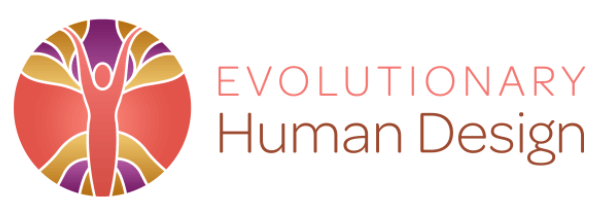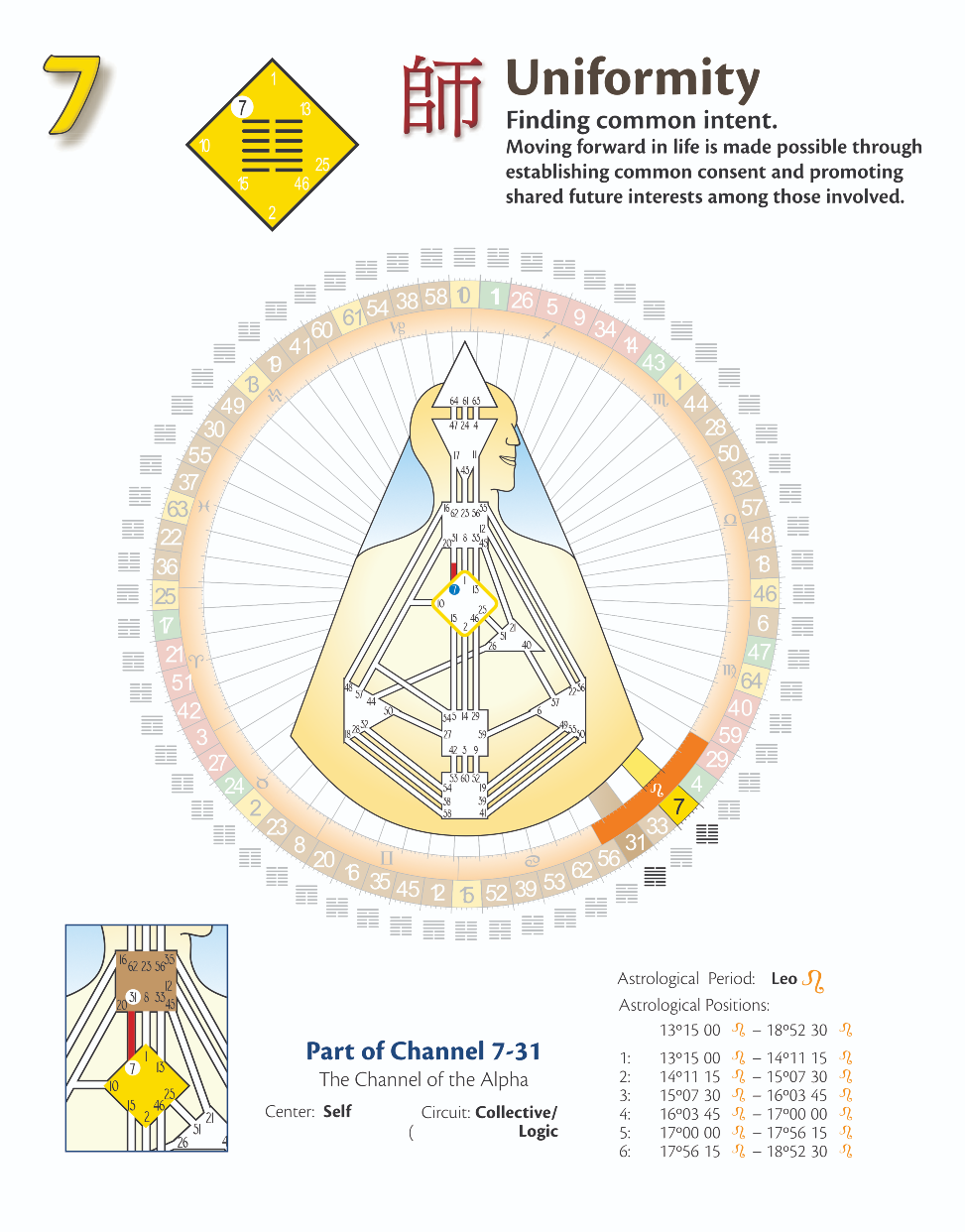Last time, we explored Hexagram 33, which showed us how withdrawal and retreat can be important parts of our strategy in life. Now, the sun is moving into Human Design Gateway 7, which we call “Uniformity.”
In the traditional I-Ching, Gate 7 is called “the Army.” And it’s important that we understand the distinction between soldiers who are totally brainwashed to blindly follow any order they are given, and those who can think for themselves. Which is why I call this Gate “Uniformity.” Uniformity is about people being able to find common intent—being able to draw people together and aim their intention toward the future. After all, the 7th Gateway is in the Logic Circuitry, and we know that logic is always aiming toward the future. It’s about moving forward, progressing in a methodical, logical way.
The 7 makes up a potential channel with the 31, which is the gateway of influence. The 31 is a voice that expresses concepts, ideals, plans, etc., and the 7 is where these things start to take shape, where we lay out the program for moving these things forward. It’s a channel of logical leadership. So, as we get into this 7th Gate, we’ll see that it all has to do with this question: How do we find ways to bring about consensus—ways in which people can combine their intentions to move us towards an assured future?
Let’s see what we find as we go through Human Design Gateway 7 line by line:
First Line: Being Disciplined
The first line is called “Being Disciplined: Effective coordination relies on the quality of shared commitments.” In any shared endeavor, there must be discipline, both self-discipline and discipline among those involved.
Good leadership is achieved by establishing order and making intentions clear. In order for people to subscribe to something, to really get behind something and put themselves into it, they have to feel like they’re involved; they have to have the sense that they have a stake in the endeavor. And in order to engender any sort of commitment from people, your intentions must be crystal clear from the outset.
You promote coordination and cooperation by launching a friendly yet disciplined course. A friendly approach allows you to gather support by making people feel engaged and involved with whatever it is you are proposing. But being easily distracted causes you to lose touch with the real needs of any situation. Any time we set a plan in motion, there is the potential for distractions to arise. People have their own lives and their own agendas, and things can easily pop up that pull them in all different directions. Which is why it comes back to the baseline of discipline here: clear intention and clear communication all the way through.
Second Line: Equanimity
The second line always has a natural approach to things. They have a natural way of getting people on board and drawing them together. And here, the line is called, “Equanimity: Rewards come from implementing any natural advantage.” Just like water naturally finds the easiest pathway downhill, second lines have a natural way of seeing and directing consensus.
Your leadership endures by aligning with or taking advantage of those being led. You have the ability to inspire. And again, this is just a natural ability. People naturally feel inspired and reassured by you and your ability to point out the easy way to get things done. But with this comes the potential to take advantage of that trust.
You have the potential, once elected, to indulge your self-interest before all other issues. We see this kind of performance all around the world. Power can be very seductive. People get put into a position of authority, and then they do whatever they feel like, or they just follow the party line with little regard for why they were elected in the first place, and they get paid handsomely for it. If you aren’t aligned with the needs of those you are leading, you end up only serving yourself.
Third Line: Disorder
Third lines like to experiment with life. They try things out, never quite sure if they want to fully commit or not. Here, the line is called, “Disorder: A reluctance to acknowledge or be drawn into hierarchies of any sort.” So, in this context of uniformity, the third line can have a slightly disruptive effect.
The nature of the third line here is to find order in chaos through playing many, often separate and divergent, roles. There’s no fixed path. There’s always the possibility of going on a tangent. You play many varying roles without ever necessarily finding a consistent one. So, when considering the question of how to bring about consensus, the third line sees that there’s possibly more than one way to do it.
You can make up many reasons to avoid commitment by undermining the purpose of anything. There’s a tendency to just keep pulling the foundations out of everything that gets started. And we’ll see this when the sun goes through this third line: all kinds of structures and things that we thought were well organized and set in place, are all going to start coming unglued.
Fourth Line: Disengaging
Here, the fourth line is a very interesting one. It’s called “Disengaging: Leadership in the highest integrity knows when and how to withdraw.” Fourth lines love consensus. They love when everybody’s on board. But with this line, it’s basically not necessarily getting the consensus.
Your strength in leadership is in identifying situations where it is best to withdraw. For example, as a coach, when your client is not doing their homework and it’s like pushing a boulder uphill to get them engaged, the fourth line approach says, “That’s fine. Go work with somebody else. I don’t have to take you on as a client.” And the same thing also expands into our lives. We don’t have to go along with a pathway, situation, or dogma that’s been prescribed to us. We can stop buying into it. We can go and find things that really do work for us.
Your unwillingness to ever stop advancing will eventually lead to your being abandoned. This is a warning of sorts for the dogmatic situations that are set up in the world at the moment. Whether it’s with climate change, regressive laws, or religious dogma, sooner or later, dogma has to come unglued. We cannot stay on a railroad track that’s not going anywhere.
Fifth Line: Directing
Fifth lines are the natural leaders. They have a vantage point from which they can oversee everything that’s going on around them. And here, the fifth line is called “Directing: The confidence and ability to instruct others in the needs of the moment.” The key words here: of the moment. Yes, you can look into the future. Yes, you can see how things can come together, but what is the instruction needed for this particular moment in time?
If you’ve got the fifth line in your chart, you’ll know that everybody sooner or later looks to you for instruction and guidance. So, your clear communication, in word and deed, is essential. You have to walk the walk. It’s fine and good to point out all the possibilities and potentials, but is it practical? Can you actually walk the walk? Can you lead by example?
You have the capacity to attract and sustain loyalty by honoring those being led. I think all of us, at one time or another, have put our trust in somebody only to find out they didn’t really know what they were up to. They might have made a lot of noise that sounded good at the time, but it didn’t take us where we needed to go. So, there is a responsibility in being a leader to really honor those who put their trust in you.
Sixth Line: Meritocracy
The sixth line is called “Meritocracy: Assigning responsibility and guidance to those who merit it.” What is the best way forward for humanity? What is our logical progression leading towards? The sixth line, which can see all the potential, can see that what we’re aiming towards is a meritocracy where people are responsible because they are informed and clear in what it is they’re doing, what it is they’re proposing, and how they’re going about it.
You remain flexible in using resources well or become unwilling to lose personal control. When you grasp on to personal control, you end up manipulating things to your own ends and away from their natural course. It’s a lot harder sometimes to remain flexible and let things play out in their own way without trying to grab the wheel.
You communicate responsibility in ways that everyone feels included and uplifted, but if you ever communicate responsibility as blame, you’ll upset the common intent. It’s like being a manager on a team, or a team captain. If you just yell and scream at your players and blame them for every loss, you might get a little extra effort out of them for a while, but that never lasts long. Eventually, the resentment boils over. But, if you cultivate a cooperative spirit, a cohesive unit with a culture of togetherness, they end up playing their hearts out for you because they want to, because they feel honored and included. And you’ll find that the managers with the longest tenures (in sports and elsewhere) tend to operate this way.
So, as the sun goes through Human Design Gateway 7, things will be shifting all around us energetically. We might not always perceive it, but nature is always moving on. We’ve just gone through the Quarter of Civilization—this period where we’ve been expressing concepts, ideas, stories, and beliefs. So now, what are we going to do about it? Let’s pull it all together and see what happens going forward. Let’s find the consensus, the conformity, and the uniformity for the next stage to come.
That’s Human Design Gateway 7. We’ll check in again soon. In the meantime, if you’d like to learn more about how your Design informs and shapes your life, get your Free Human Design Report today.




